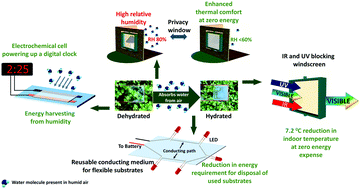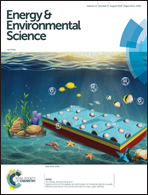A super hygroscopic hydrogel for harnessing ambient humidity for energy conservation and harvesting†
Abstract
Atmospheric humidity, an abundant source of water, is widely considered as a redundant resource demanding expense of energy to maintain it under comfortable levels for human habitation. Until now, there have only been a few attempts to harness humidity for applications such as water collection and hygro-induced movements. Herein, we report an unprecedented moisture scavenging gel that is capable of absorbing around 230% of its weight with water from humid atmospheres. Additionally, the gel has humidity-triggered changes in optical, electrical, and electrochemical properties that can be exploited for a wide range of applications such as thermo-hygroscopic windows, infrared radiation (IR) blocking windscreen, and construction of an electrochemical cell for energy harvesting. Integration of a thermo-hygroscopic window and IR blocking windscreen leads to extensive energy savings in buildings. Furthermore, the applicability of the gel as a conducting medium in flexible electronic substrates enables reusability of printed circuit boards, mitigating the volume of solid electronic wastes and the energy required for their disposal. To the best of our knowledge, this is the first attempt at harnessing ambient humidity as a sustainable resource for energy conservation and harvesting.

- This article is part of the themed collection: 2018 Energy and Environmental Science HOT Articles


 Please wait while we load your content...
Please wait while we load your content...